Introduction
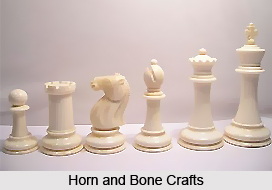 Horn and Bone craft is the cultural heritage of the artisans of Paralakhemundi, located in the Gajapati district of Orissa. The artisans were originally carpenters by birth and profession but turned to horn and bone crafts during the reign of Sri Krushna Chandra Gajapati Narayan Deb, the Maharaja of Paralakhemundi.
Horn and Bone craft is the cultural heritage of the artisans of Paralakhemundi, located in the Gajapati district of Orissa. The artisans were originally carpenters by birth and profession but turned to horn and bone crafts during the reign of Sri Krushna Chandra Gajapati Narayan Deb, the Maharaja of Paralakhemundi.
Origin of Horn and Bone Craft
The origin of Horn and Bone Craft has not yet been deciphered. It is believed that K. V. Appa Rao is the father of horn craft in its present form. Maharaja of Paralakhemundi patronized him for his craftworks, especially for a particular variety in which the hollow part of the horns was used as a container. Once the king came across an exquisitely carved wooden crane and was inspired to get a similar one made of horn. The same was carved out of the solid part of a horn which highly pleased the Maharaja. Appa Rao with his innate business acumen assessed the potentiality of the craft and set up a workshop. Efforts were made to introduce new designs and more sophisticated tools. Since then, the very word Paralakhemundi became synonymous with horn craft.
Artefacts of Horn and Bone Craft
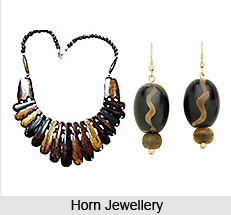 Horn articles of Paralakhemundi are mystical and are embellished with superb designs. The testaments of this brilliant craftwork include stylized birds and animals which seem alive. For instances, cranes look as if they could talk if they opened their beaks and the birds appear to be twittering. Delicate works of silver filigree are sometimes added to the horn articles to make them even more appealing. Items like bangles, perfume jars, traditional combs, jewellery, tobacco pipes and many other artefacts are also furnished by this craftwork. In Cuttack horn and filigree works are combined to produce decorative jewelleries. Other important centres include Sarai Tarin in Uttar Pradesh, Honawar in Karnataka and Thiruvananthapuram in Kerala. The craftsmen of Thiruvananthapuram are famous for making different kinds of crane birds with horns. Pen stands, table lamps, paper weights, lamp shades, snuff boxes, walking sticks, vermilion contain are other common products. However, the list remains incomplete without the mention of the horn deities, especially Lord Jagannath. Influences of both ancient and modern arts can be seen in the artefacts of Horn and Bone Crafts. Flora and fauna, mythical figures and, in fact, the entire gamut of creation can be witnessed in this craftwork.
Horn articles of Paralakhemundi are mystical and are embellished with superb designs. The testaments of this brilliant craftwork include stylized birds and animals which seem alive. For instances, cranes look as if they could talk if they opened their beaks and the birds appear to be twittering. Delicate works of silver filigree are sometimes added to the horn articles to make them even more appealing. Items like bangles, perfume jars, traditional combs, jewellery, tobacco pipes and many other artefacts are also furnished by this craftwork. In Cuttack horn and filigree works are combined to produce decorative jewelleries. Other important centres include Sarai Tarin in Uttar Pradesh, Honawar in Karnataka and Thiruvananthapuram in Kerala. The craftsmen of Thiruvananthapuram are famous for making different kinds of crane birds with horns. Pen stands, table lamps, paper weights, lamp shades, snuff boxes, walking sticks, vermilion contain are other common products. However, the list remains incomplete without the mention of the horn deities, especially Lord Jagannath. Influences of both ancient and modern arts can be seen in the artefacts of Horn and Bone Crafts. Flora and fauna, mythical figures and, in fact, the entire gamut of creation can be witnessed in this craftwork.
Making of Horn Crafts
Cow horns, Buffalo horns, stag antlers and tusks are used in horn crafts. The desired object is carved out from the solid part of a horn after soaking it in water. For further shaping, the carved pieces are heated to a specific temperature and are softened. The surface is then smoothed down with the help of a rough file, flat file, half round file or a sharp stainless steel blade. Necessary bores are made to fix appendages. Polishing is the next step in the making of these crafts which is done by rubbing the articles first with sand paper and then with wet Khrshana leaves. The polishing is continued till the horn becomes smooth and shiny. These are then thoroughly cleansed with water and dried in open air. After drying these are further polished with cow dung ash or charcoal ash. Applying limestone paste or white varnish highlights the desired areas. Finally coconut oil is smeared all over the artefact to render a beautiful sheen.
Making of Bone Crafts
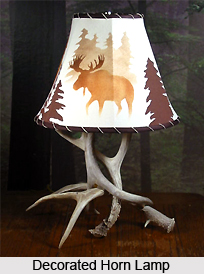 Similar to the horn crafts, making of bone crafts also involves a series of elaborate procedures. Raw bones of dead animals are firstly cut into desired sizes and are immersed in water for 12 hours. This process softens the bone. Later these pieces are scrapped and cleaned and are shaped according to the artefact, on a lathe. Carving is done with the aid of a file drill. Polishing, colouring and designing of these articles in varied patterns are the final steps in the making of bone crafts.
Similar to the horn crafts, making of bone crafts also involves a series of elaborate procedures. Raw bones of dead animals are firstly cut into desired sizes and are immersed in water for 12 hours. This process softens the bone. Later these pieces are scrapped and cleaned and are shaped according to the artefact, on a lathe. Carving is done with the aid of a file drill. Polishing, colouring and designing of these articles in varied patterns are the final steps in the making of bone crafts.
Designs of Horn and Bone Craft
Designs on the bone carving exhibit a variety of motifs including floral and figurative patterns. Influences of Mughal architecture can also be traced on these crafts. Initially, ornaments were prepared with natural bones, but later use of vibrant colours became an alluring fashion. Some of the artefacts are also adorned with natural stones like feroza, topaz, quartz etc which augment their elegance and beauty.
Numerous articles including jewellery, ornate table lamps, chess-sets, cigarette holders, napkin rings, salt and pepper sets, laughing Buddha, chess sets, animal figures, decorative plaques, bridges of animals, paper cutters, tooth picks, hair pins, bangles, lockets, necklaces, figures depicting Indian dances etc are the mesmerizing manifestations of Horn and Bone Crafts. The charm of this craftwork fascinates people not only of the county but also of different parts of the world, irrespective of age groups and cultural backgrounds. With the help of a number of adept artisans, India has acquired considerable fame in Horn and Bone Crafts, all over the world.
Horn and Bone Crafts of Eastern India
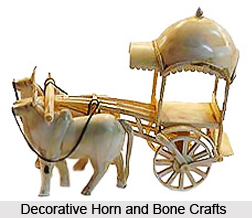 Horn and Bone Craft of Eastern India are highly acclaimed owing to their exquisite and intricate designs. Ancient texts and archaeological evidences have also consolidated the prevalence of this craftwork in India since time immemorial. Crafting beautiful and artistic products from the horns and bones of cattle require eloquent skill and artistry. A range of artefacts can be found in this craftwork including home d‚cor items, jewelleries, walking sticks, chess sets, combs and many more.
Horn and Bone Craft of Eastern India are highly acclaimed owing to their exquisite and intricate designs. Ancient texts and archaeological evidences have also consolidated the prevalence of this craftwork in India since time immemorial. Crafting beautiful and artistic products from the horns and bones of cattle require eloquent skill and artistry. A range of artefacts can be found in this craftwork including home d‚cor items, jewelleries, walking sticks, chess sets, combs and many more.
Horn and bone craft in Orissa
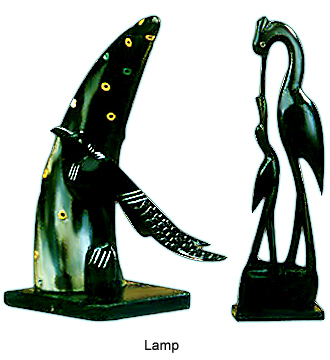 Horn bone craft in Orissa is known for their richness in creativity and luster. The artisans of Paralakhemundi located in Orissa`s Gajapati district, create different artistic items out of horn bone and these are considered to be the conveyors of rich cultural heritage of Orissa.
Horn bone craft in Orissa is known for their richness in creativity and luster. The artisans of Paralakhemundi located in Orissa`s Gajapati district, create different artistic items out of horn bone and these are considered to be the conveyors of rich cultural heritage of Orissa.
Horn bone craft in Orissa display an amalgamation of artwork and creativity. The artifacts are sometimes done with a little touch of filigree work on them to give them a different look. The items created with horn and bones are the examples of lively appearance, animation and dynamism. Before creating different items the artisans` make the horn is smoothly polished and then shape them into various moulds. In Cuttack, the horn and filigree works are commingled to create decorative jewels as well as bangles and other ornaments. Apart from these items the artisans of Orissa also make articles of daily use and utilitarian items such as combs, pen-stands and flower vases using the horn of cattle. Contemporary artisans use the cow and buffalo horn to make more utility items like ashtrays, jewelry and combs. Cranes, lobsters, scorpions and birds made of horn are finished to a subtlety. It is quite evident that when it comes to Horn Work, Orissa, quite a variety is on offer.
Not only these, but the horn bone craft in Orissa also offers an array of items made out of ivory. This is an ancient and traditional craft form prevalent in the state for ages. This craft is primarily practiced by the tribes of Santhals, Orans and Marijas. Following the traditional designs the artisans make figurines of animals and birds. The combined style of filigree work in horn bone and ivory is more prevalent in Cuttack. Beautifully carved combs of bones and horns are popular all over the world.
Horn and bone craft in West Bengal
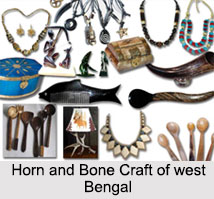 The craftsmen of West Bengal has gained the admiration of the nation with their fine works of artistry but their main piece of artefact was the making of horn and bone crafts. The horn craft of West Bengal portrays the traditional affluence of the past reign. It is known that from the ancient ages of the Indian civilisation, horn combs were shining black and had translucent shades of grey. These pieces of art adorned the tresses of women in those times. Back in the day, in West Bengal, the artisans of a village called Baishnabchak in Midnapore did a flourishing business in horn combs. Combs made out of horn were trusted to be excellent for the hair and scalp. But soon after, the horn combs began to lose ground in the market because of its appearance and the availability of cheaper plastic combs. To overcome the crisis, the State Government introduced different measures for diversification and today, the craftsmen are engaged in the production of a wide range of horn products like walking sticks, pen stands, napkin rings, spoons, knobs and handles etc.
The craftsmen of West Bengal has gained the admiration of the nation with their fine works of artistry but their main piece of artefact was the making of horn and bone crafts. The horn craft of West Bengal portrays the traditional affluence of the past reign. It is known that from the ancient ages of the Indian civilisation, horn combs were shining black and had translucent shades of grey. These pieces of art adorned the tresses of women in those times. Back in the day, in West Bengal, the artisans of a village called Baishnabchak in Midnapore did a flourishing business in horn combs. Combs made out of horn were trusted to be excellent for the hair and scalp. But soon after, the horn combs began to lose ground in the market because of its appearance and the availability of cheaper plastic combs. To overcome the crisis, the State Government introduced different measures for diversification and today, the craftsmen are engaged in the production of a wide range of horn products like walking sticks, pen stands, napkin rings, spoons, knobs and handles etc.
Bengal horn is still a fascinating craft, the villages of Baishnabchak and Joleghanshyanof, Gupiganj, Baruipur, Malda and some other areas around Kolkata are engaged in horn handicraft. There are over 400 skilled artisans from in and around these places, who are still the bearer of this ancient tradition. The chief centres of horn comb used to be in erstwhile undivided Bengal, the roots of it go back to Dacca and Bakhargunj, also known as Barisal in Bangladesh. These handicrafts of horn and bone are most commonly made from animals like the buffalo, camel, elephant and cow. In West Bengal, buffalo horn is the most common one, where the horn is heated, flattened and then cut and shaped or carved accordingly. In some states, like Uttar Pradesh and Rajasthan, the use of camel bone is very common in the inlay while making jewellery.
Horn bone crafts in West Bengal include making exotic pieces like bullock carts, trail of elephants, patterns carved on the complete tusk, engraved jewellery boxes, chariots with horses and many more with immense dexterity. The craftsmen are skilled in creating holy figures and deities like Goddess Lakshmi, Goddess Durga and Lord Ganesh out of horn bones. Some places of West Bengal were greatly admired as the artisans used to create gorgeous ivory panels which were part of the beds, "simhasans" or the royal chairs, palanquins, thrones. Moreover, artisans of Midnapur still make combs from horns which are meticulously embellished in varied shapes and fashions.
The horn bone crafts stand unique because of the fusion of different motifs while still upholding the past traditions of Bengal with a tinge of contemporary touch. The present market scenario of these object show that the artisans have the potentiality to adapt to understand the demand of the mass and modify accordingly.
 Horn and Bone Crafts of Jharkhand
Horn and Bone Crafts of Jharkhand
Jharkhand State of Eastern India has also gained popularity in horn and bone craftwork. Hazaribagh district of Jharkhand is well acclaimed in producing gorgeous products carved out of horns and bones. Adorned with gold and silver, jwellaries made of horns and bones exhibit uniqueness and elegance. Bone bangles are found in a variety of designs, shapes and colours that match perfectly with different choices and attires of people. College goers have a great craving for such jewelleries. In addition to jewelleries, the craftsmen of Jharkhand also furnish a wide range of admirable decorative items.
Horn and Bone Crafts of Bihar
Horn and bone crafts have also found a significant place in the ancient crafts of Bihar state of Eastern India. Wood inlay ornamented with horn and bone craftworks are beautiful testaments of artistic mastery of Bihar. Wall hangings, trays and many other items of home decors are some of the most cherished products. Household items made of horns and bones are also very popular in Bihar.
Horn and Bone Crafts of Eastern India exhibit both traditional as well as contemporary styles. Designs in such crafts include floral, figurative and other motifs. Inspirations from Mughal architecture are quite evident in some artefacts whereas some of them depict Indian mythology in traditional yet wonderful styles. These crafts are quite famed for their explicitly beautiful designs and alluring styles. This brilliant craftwork attracts people not only from India but also from all over the world.
Horn and Bone Crafts of Southern India
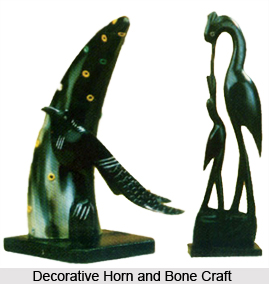 Horn and Bone Crafts of Southern India are among one of the most prominent crafts of the country. Spectacular in designs, this craftwork offers a tremendous range of artifacts having decorative and utilitarian significance. Southern India has a rich heritage of horn and bone craftwork which is prevalent since ages. The endless list of items in this artistry includes salt and pepper sets, miniature animal figures, wall hangings, cigarette cases, paper cutters, tooth picks, bangles, depiction of Indian dances and many more.
Horn and Bone Crafts of Southern India are among one of the most prominent crafts of the country. Spectacular in designs, this craftwork offers a tremendous range of artifacts having decorative and utilitarian significance. Southern India has a rich heritage of horn and bone craftwork which is prevalent since ages. The endless list of items in this artistry includes salt and pepper sets, miniature animal figures, wall hangings, cigarette cases, paper cutters, tooth picks, bangles, depiction of Indian dances and many more.
Horn and Bone Crafts of Kerala
Kerala is one of the most important centers of Horn and Bone Crafts in Southern India. Lovely artifacts including toys, miniature animals, paper weights, flower vases, small boxes, lamps, ashtrays etc are the manifestations of this artistry. Places like Kasaragod, Cochin, Trivandrum, Ernakulam and Trichur, in Kerala, are well reputed in this craftwork. Horn and bone crafts are bestowed with exquisite variety of designs and vibrant colours. Designs range from contemporary to traditional styles. Designs are delicately engraved with the aid of a chisel. One of the most common manifestations of this craftwork includes representation of mythological figures like Lord Ganesha, Shiva-Parvati, Vishnu Saraswathi, Goddess Lakshmi and Nataraja. Apart from carving out designs, etching them on the surfaces of horn crafts is also another common practice. Horn and bone crafts comprise of various designs including floral and geometrical patterns and other beautiful scenes. In Thiruvananthapuram, the artisans of Viswakarma Community are well known for this art.
The horn bone craft in Kerala is noted for its deft artistry and accurate use of the material. The craftsmen of the state use the raw material which is available in every sects of India with ample variations and in different colours.
Horn bone craft in Kerala is carried out in Trivandrum, Trichur, Kasaragod, Ernakulam, and Cochin. The horn bone craft in Kerala is the sector where the artistry of the craftsmen was displayed with all its flamboyance. The efficiency and skills of the master craftsmen were the foremost factor that helped to develop this craft in Kerala. Craftsmen belonging to Viswakarma Community in Thiruvananthapuram are mainly adept in this art.
The horn bone craft in Kerala needs to soften and malleable before giving it a proper shape. This is processed in a particular way that includes heating and oiling the horn bone. The grains of the horns are coalesced with colors and molded into exquisite pieces that catch the fancy of people. Sometimes the horns are pared and carved into different forms. The artistry is raised to the supremacy when horn carving is combined with dark wood.
There are motley of products that are made out of horn are models of birds and animals, toy furniture and small snake boats. The cranes of Kerala are very famous and sometimes the artisans use buffalo horns to give them proper shape. The continues with a vast array of utilitarian items like paper weights, vases, buttons, trays, pen stands, lamps, combs, cigarette cases, ashtrays, cranes, animals like elephants and tigers, toy furniture, and miniature snake boats, graced combs and hair pins that are popular among the mass. These pieces serve a dual purpose by possessing utility value as well as exclusive decorative pieces.
In earlier period, the horn bone craft in Kerala included creating images of deities and sacred animals. These items were made with great care avoiding damage to the raw material. Even today thee horn born craft is still practiced in Kerala where the artisans put much effort to amalgamate the traditional designs with their artistry. Sometimes the items are given a touch of fusion keeping in mind the modern preferences. Not only are the artisans jutting in the Indian market, but are also considering the international market to promote the sales of horn bone craft in Kerala.
Horn and Bone Crafts of Karnataka
Horn and bone crafts are also extensively practiced in Belgaum district of Karnataka. Ornamental and decorative items furnished by the artisans of this district are very popular in India. The most common product in this area is the traditional comb adorned with intricate designs. Apart from this, bone jewellery, hair pins, buttons, pen stands, trays etc are also crafted with cattle horns. When combined with metal works, these crafts exhibit brilliant appeal.
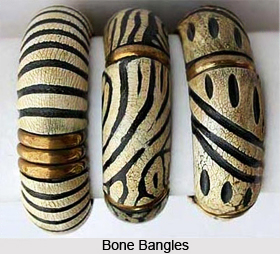 Horn and Bone Crafts of Tamil Nadu
Horn and Bone Crafts of Tamil Nadu
Tamil Nadu has also gained acclamation in terms of Horn and Bone Crafts in Southern India. Chennai is one of the leading manufacturers of this craftwork. Antique crafts made out of horns are prepared by adept artisans. Jwellaries including necklaces, bangles etc. are much adored by youngsters. Craving for such jewelleries can also be witnessed among the foreigners from different parts of the world. Besides this, many home d‚cor items are also crafted. They are designed in a range of shapes and designs with vivid colours. These crafts have a fine finish and are greatly charming in their own unique way.
Horn and Bone Crafts of Andhra Pradesh
Vishakhapatnam, in Andhra Pradesh, nests some skilled craftsmen furnishing alluring horn and bone crafts. Walking sticks are a speciality of this area. Horns serve as a versatile raw material owing to its easy and widespread availability. Horns are softened by heating and oiling and are shaped in different ways embellished with delicate and elaborate designs. Bison horns serve as an excellent raw material because of their large sizes.
Crafting of Horn and Bone Crafts
Horn and Bone Crafts of Southern India are manifestations of a series of complicated and elaborate steps. Initially the horns and bones are soaked in water and are heated to make them soft to carve them in desirable shapes. Engravings are done on them with intricate designs and are coloured with vivid hues. Polishing with charcoal, coconut oil and limestone is the final step in their processing.
Combination of horn and bone crafts with other types of artistry like metal works and stone works always intensify their beauty. Gems like topaz, quartz and feroza are often embedded on them to enhance their appeal. The designs in these crafts also include a wide variety of patterns of both modern and traditional styles and inspirations from ancient arts can also be traced on them. Horn and bone crafts are the testaments of pure artistic mastery which attract people from all over the world.



















